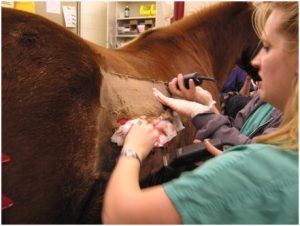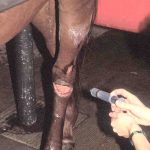Large animal wounds
Wound evaluation
Wound management in the field involves balancing the three parts of the equation:
- The wound
- The patient
- The environment
Wound care can be straightforward in the appropriate environment with a well mannered horse. However, referral should be strongly considered with an ill-tempered horse or an unsafe environment even with simple wounds. Horses with significant blood loss, unstable limbs (fractures or tendon damage) and/or with potential synovial involvement should be referred as soon as possible. Call the hospital to determine what splints or medical therapy is needed to support the animal during the drive. The following describes steps for cases without complications. If critical structures are damaged, the process should be stopped, conversations held and the horse readied for transport if indicated. Euthanasia may be needed.
Sedation
Sedation is often necessary to evaluate equine wounds. Remember: xylazine should not be used alone for hindlimb procedures. We typically combine alpha adrenergic agents with butorphanol:
Standard sedative doses for a 500kg horse –
150-250 mg xylazine +/- 5-10 mg butorphanol iv
5 mg detomidine +/- 5 mg butorphanol iv
Acepromazine is a long acting sedative that is hypotensive. It should not be used in stallions, geldings with penile injuries or horses with significant blood loss. Otherwise, a combination of xylazine, acepromazine and butorphanol (“RAT”; 10mg ace + 200 mg xylazine + 10 mg butorphanol/500kg horse) is very useful for ill-tempered horses.
Most cattle do not need sedation. If sedation is required, xylazine (10-20mg) is usually effective. Cattle do not typically have the head down/kick fast response that horses do (unless it is a Swedish Highlander). Injured small ruminants can be safely sedated with midazolam/butorphanol. Camelids may sedate with butorphanol if not already excited; otherwise xylazine + butorphanol may work better. Pigs are generally best when held by their owners, if possible.
See the chapters on sedation for more details.
Wound cleaning
The wounds should be cleaned of gross debris. The wound can be covered with sterile lube or gauze to protect it while the hair surrounding the wound is clipped and the wound margins cleaned with betadine scrub. The soap can be removed with distilled water or alcohol. Chlorhexidine is more toxic and should be used only in very dilute concentrations.

Once the wound edges are cleaned, the surface of the wound can be wiped off with tap water, sterile saline or commercial wound cleanser (0.05% chlorhexidine, 0.1% povidone iodine). In humans, tap water is less damaging and more effective than sterile saline.
Sharp debridement is then used to remove the contaminated tissue surface unless the removal of tissue could lead to issues (open a synovial structure, prevent eyelid laceration closure). Exposed bone may be rasped to clean to bleeding layers.
While lavage is useful, avoid high pressure lavage that may force bacteria and debris deeper into the tissues. Optimum pressure is 13 psi. A 12 mL syringe + 22 g needle or 35cc syringe + 18ga needle creates a good level of force. Dilute povidone-iodine solutions may help with contaminated wounds.

Hydrogen peroxide is also bad for wounds. The bubbling creates new tissue planes and it is cytotoxic.
At this stage, the wound should be evaluated for damage to deeper structures. Put on a sterile glove and digitally palpate.
- Is bone directly palpable? fragmented?
- Is cartilage palpable?
- Is there additional debris in the wound?
- Are there tissue pockets that will collect debris and bacteria?
- Other structures damaged?
Resources
BEVA primary care clinical guidelines: Wound management in the horse. Equine Vet J. 2021;53:18–29.
Diagnostic Approaches to Understanding Equine Limb Wounds, VCNA Vol.34(3), pp.461-471, 2018 pdf

